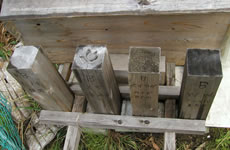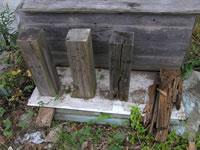| |
|
Newsletter -SAFETY OF OUR FOODS AND LIFE-
* Japan Offspring Fund – Our activities and ideas Part 2 Kowaka Junichiro, founder and director of Japan Offspring Fund, comments on the difference between the issues that NGOs and governments deal with, and how NGOs addresses different issues and problems directly. * Wooden houses: Danger of collapse Japan Offspring Fund talked to the expert, Mr. Masato Enokido, about the approximately 1,000,000 wooden houses that are built using low quality lumber. He is warning that many wooden houses may collapse as the wood quickly starts to rot. The problem is the use of spruce ( Picea abies ) or whitewood, which is easily attacked by termites.
Japan Offspring Fund – Our activities and ideas By Junichi Kowaka, director, Japan Offspring Fund “Japan Offspring Fund is so well-known, you have power, please prohibit the dangerous substance called XYZ!” When we hear this kind of opinion, we feel that there is confusion about the role of non-governmental organizations (NGOs), and that we are mistaken as having power like political parties and political organizations. Actually, NGOs have no power at all over the government. Actually, political groups with power never talk to groups like us, who directly address problems and issues. No wonder there are misunderstandings among ordinary people. The civil society movement covers a wide range of issues. Japan Offspring Fund is a NGO that covers both consumer issues and environmental issues, and we express ourselves in a different way compared to political organizations. If we go and say our opinion or present a proposal to the government, they listen only temporarily. It is a common affair that they do not want to be pushed in either direction. For politicians acting within political organizations, the situation is different. The government really has to answer if they get questions in a hearing in the Parliament, and desperately find solutions to the problems that arise. Thus, it may seem that NGOs have no reason to exist, since they can never expect to influence the government. I strongly disagree with this way of thinking. The weak point of politicians is “raising an issue”. Whenever a problem or issue appears, the industry that is challenged or criticized immediately starts a major effort to threaten the active politicians and the political organizations, which have to consider the upcoming elections. For example, this year an important theme for Japan Offspring Fund is contaminants such as 3-MPCD in commonly used food ingredients and additives, especially chemical flavorings or seasonings. But we really doubt that any politician will take up this problem and genuinely criticize the food industry. The large companies that produce food additives and use such ingredients are actively supporting certain politicians to get elected. Because they fear retaliation in the upcoming election, the politicians cannot be the first to criticize the big food companies. NGOs and citizens groups do not have the burden to win elections. This means we are free to raise issues and discuss problems even if they are not obviously breaking any laws. If NGOs can get a lot of support for a campaign, then politicians and the government will be forced to find solutions. Japan Offspring Fund is such organization, a citizen's group that addresses problems directly. Our role is not to campaign until society has finally decided that the dangerous substance will be banned. We can only start the process, and let the awareness of the citizens take over, and do the rest. In the next issue, I will discuss why we are not involved in campaigns to collect signatures for different petitions.
Wooden houses: Danger of collapse In the recent scandal in Japan , some 700 new apartment buildings were found to be unsafe in case of an earthquake. However, a much bigger problem is going unnoticed. We talked to the expert, Mr. Masato Enokido, about the approximately 1,000,000 wooden houses that are built using low quality lumber. He is warning that many wooden houses may collapse as the wood quickly starts to rot. The problem is the use of spruce ( Picea abies ) or whitewood, which is easily attacked by termites. Suddenly since 1999, spruce has become very common in residential housing in Japan . The spruce laminated together is however easily attacked by termites, a serious problem since it leads to rapid rot. Spruce is imported from Sweden , Finland , Germany , etc. In such cold countries, termites are perhaps not such a big problem, but as the wood is used in Japan , and exposed to a hot and humid climate, the wood is rapidly disintegrating. Lets not forget that after WW2, Japan started importing a lot of wood from North America , especially Western Hemlock ( Tsuga heterophylla ). After about 25 years, it was commonly noticed that this type of lumber rotted, for example around the bathroom. Actually, spruce rots even faster than hemlock. Unsafe in case of earthquakes Experts are now warning that wooden residences using spruce are unsafe and in danger of collapsing in case of an earthquake. Of course, chemical treatment is used to preserve lumber, in addition to termite extermination measures. But, since the chemicals are only applied to the surface of the lumber, it cannot protect against rot. In the 1995 earthquake in Kobe , a large number of wooden homes collapsed due to rot. As low quality wood is increasingly used all over Japan , many people are at risk. Sales of wooden houses using laminated spruce has increased by 50 %, and these days about 70 % of all pre-fabricated houses are made with such low quality wood. Other problems that add to the concern is that the wood is not allowed to dry properly, and that carpenters' skills are waning. Our conclusion is that all wooden houses built after 2000 may be dangerous. We urge the construction companies to explain both the merits and demerits to the consumer. In the case where there is a 10 year warranty on the residence, it really means that we can only be sure about the safety of the house for that period of time. Many people will be continuing to pay off the house loan for a long time after the warranty has expired. The problem cannot be overlooked: your house and your property cannot be protected. If your house rots rapidly, for example due to flooding during a typhoon, you may lose up to 20,000,000 Yen. By paying 300,000 Yen more for better lumber at the time of purchasing a new residence, you can actually double the lifetime of the house. Compare these figures and you really get an idea of what is at stake. The types of wood experts now recommend include domestically grown cedar ( Cryptomeria japonica ) and cypress ( Chamaecyparis obtusa ). As such lumber is recently abundant in Japan , there is no need to use foreign lumber that rots easily in the Japanese climate. Rapid decay In this experiment, four different types of wood were compared. Imported spruce, that has become so popular in residences all over Japan since 1999, looks white and attractive when new. The four pillars were exposed to normal conditions (photo on the left). After only four years, the spruce pillar had rotted and completely lost its shape (photo on the right). It is outrageous that such low quality wood is being used for important parts, including central pillars, in the construction of residential homes. From left to right: For more details, please refer to the citizen's group Kokusanzai (Japanese only) http://kokusanzai.jp/
|
|||||||||||||||||||||||||||||||||||||||||||
|
Copyright(C) 2004 Japan Offspring Fund, All Rights Reserved. Tel:048-851-1212 Fax:048-851-1214 Mail: Please give me the subject name in Japanese. |


